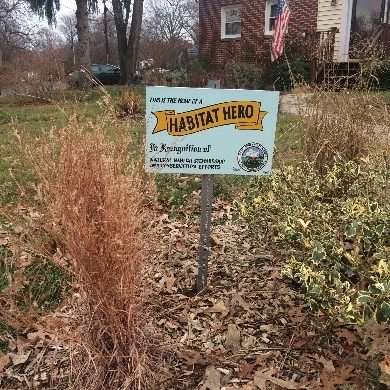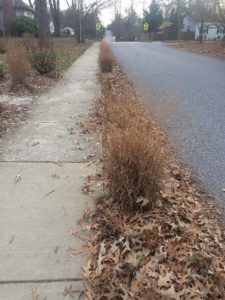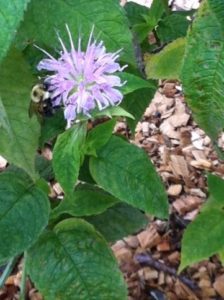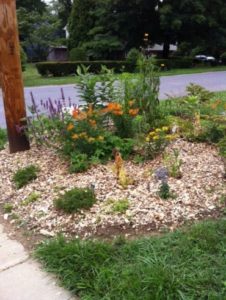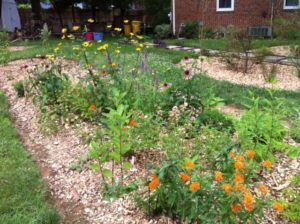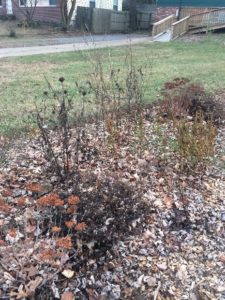
Practical Ways to Reduce Storm Water Runoff
November 11, 2019
Got Host Plants? Get Butterflies!
January 8, 2020Julianne Sharp
The end of summer and into the fall I would drive past a house on the corner of Hampton & Broadview, slowing down as I turned the corner to admire the garden islands that had been carved out, significantly reducing the size of the lawn. I would crane my neck trying to see all the different plants in the landscape- looking for natives (of which there are many). The main attraction that always caught my eye was that the gardener at this residence had planted the hell-strip along Hampton (that narrow, barren area between the road and the sidewalk) with many native plants, grasses and even tomato plants that she encourages passer-byes to pick. Finally, on a warm day at the end of December I knocked on her door and awarded her CCC’s Habitat Hero Award.
Congratulations to our 2019 4th Quarter Winner Julianne Sharp. A garden club member and longtime Cape resident Julianne has been transforming her yard into a flourishing habitat for many pollinators, including bees, butterflies, birds and small mammals. Her list of plants is extensive and includes many natives that are vital to our local fauna that have evolved together over hundreds of thousands of years. They depend on each other for survival, many are specialized to only use a particular plant to lay their eggs. Her landscape includes many layers of plants such as groundcovers, structural plants and fillers for color. The plants vary in height, color and bloom time. It is important to always having something in bloom from early to spring to late fall so that pollinators always have something to eat. She has included many native grasses as well that provide structure, habitat and nesting spots. I spied several bare areas on the property that allow solitary ground bees to make their nests.
She has been replacing the lawn which is devoid of all life by carving out many island gardens throughout the property. She has also planted Trifolium repens white Dutch clover to replace the areas that are still grass and removes the wild strawberry from the garden beds but transplants them into other areas as a groundcover. Her use of natural materials throughout the property such as a garden border from an old tree, cut into pieces is not only eye catching but provides another spot for Mother Nature to come in. She has used local tree service companies for shredded mulch, including from a tree they had cut down. Her compost piles provide rich soil to nourish the garden beds each spring.
I won’t be able to list all the plants she has but I can give you the highlights! She has a variety of native grasses including Schizachyrium scoparium “Standing Ovation” Little Bluestem, Sisyrinchium angustifolium “Lucerne” narrow-leaf blue-eyed grass, Chasmanthium latifolium Northern Sea Oats, Panicum virgatum “Shenandoah” Switchgrass, Eragrostis spectabilis Purple Lovegrass and a grass-like plant Carex Appalachica Appalachian Sedge.
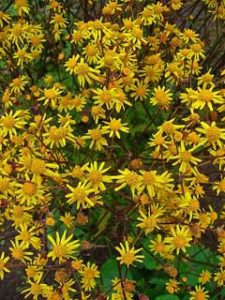
Her native fern selection includes Onoclea sensibilis Sensitive fern, and Polystichum acrostichoides Christmas fern. Groundcovers include Anemone canadensis Canadia anemone, Chrysogonum virginianum Green and gold, Erigeron pulchellus “Lynnhaven Carpet” Robin’s plantain, Geranium maculatum Wild geranium, Mitchella repens Partridge berry Pachysandra procumbens Allegheny spurge, and one of my favorites for a shady spot Packera aurea Golden ragwort.
Julianne also has huge selection of flowering native perennials that provide plenty of nectar for the bees, butterflies and other pollinators. Agastache “Blue Boa” Hyssop, Asclepias syriaca Common Milkweed, Asclepias tuberosa Butterfly weed Amsonia hubrichtii threadleaf bluestar, Coreopsis verticillata Whorled tickseed, Echinacea purpurea Purple Coneflower, Heliopsis helianthoides “Summer Nights” Smooth oxeye, Lobelia Cardinalis Cardinal Flower, Phlox paniculata Garden phlox, Rudbeckia hirta Black Eyed Susan, Aquilegia Canadensis Wild columbine, Spigelia marilandica Indian pink ,Tiarella cordifolia Heartleaf foamflower and Tradescantia “Sweet Kate” Spiderwort.
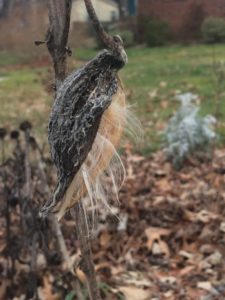
Rounding out the list are some very important fall blooming nectar plants. As I mentioned above it is important to always have something in bloom. In early to late fall the monarchs begin their fall migration and Julianne has several varities of Asters, including New England Aster and Aromatic Asters. The purple of the asters works as a brilliant combo with the golden yellow of Solidago goldenrod. She has Solidago sempervirens Seaside goldenrod and Solidago caesia blue stem goldenrod. As far as rock stars of pollinator plants go she has one of the best- Pycnanthemum flexuosum Appalachian Mountain Mint. The number of different species of bees and pollinating flies is unmatched by any other plant you can have!
Julianne is creating a habitat oasis in the middle of suburbia, on one of the main community roads. Providing a safe haven for birds, bees, butterflies, and other pollinators to raise their young, feed on nectar plants, and remain safely sheltered. She does so by providing native plants, water sources, bare soil, fallen leaves and standing stalks. When I stopped by on a December day all of her spent plant stems were still there, no doubt overwintering next year’s bees and butterflies. Julianne is doing an amazing job at supporting our local ecosystem by her gardening habits! Congratulation and thank you Julianne for being a Habitat Hero!
Please email to nominate yourself or a neighbor who you think may be the next Habitat Hero! You will have our beautiful sign for 3 months, article on our website, shout out in the Caper and a $25 gift certificate to buy more plants.


